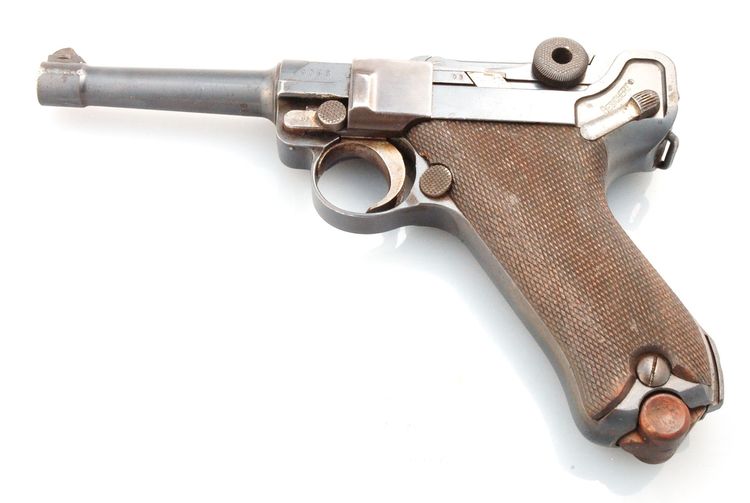Weapons, Ammunition, and Explosives
Weapons, ammunition, and explosives are the most unlikely of “hidden hazards.”
Everyone is aware that these are overtly hazardous and precautions are taken to ensure that this type of item can no longer present a hazard. Rifles and pistols are displayed in secure cabinets and often have the firing pins removed to ensure they are safe. If ever you have to handle museum firearms, it is best practice to always treat the weapon as if it is loaded until proven otherwise. Never point a firearm at anyone, even if it is unloaded. It is unprofessional, and it can still frighten people who may be unaware it is not loaded.
 Ammunition
Ammunition
Ammunition can easily be overlooked because it can be small in size and hidden within the firearm. It is a hazard during a fire. Some ammunition is made from depleted uranium, so it may be worth checking your ammunition with a Geiger counter to ensure it is not radioactive. Ammunition should always be displayed and stored securely, as well as separately from the weapon that fires it.
 Explosives
Explosives
Explosives can be overlooked when they are attached to unlikely items, such as a whaling harpoon. Explosives can also be found in old gold or coal mining exhibits, and may consist of innocuous tubes wrapped in greaseproof paper. If in doubt, assume the worst and call your local police station.
 Picric acid
Picric acid
Picric acid was used to make explosives, some medicines and Bouin’s solution, a fixative or preservation fluid that also contained formaldehyde and acetic acid. The main hazard with picric acid is finding dehydrated picric acid crystals around the metal cap of a bottle. These picric acid crystals are shock sensitive and can explode if you try to unscrew the lid. In these circumstances it is best to contact the local police, and they will contact explosive experts.
If you wish to dispose of any picric acid or items containing picric acid, contact a WorkSafe-accredited company via: https://register.hasanz.org.nz.
Alternatively, if you wish to discuss your options further, please feel free to contact the Collections team at Tūhura Otago Museum.
 Weapons
Weapons
Although it is stating the obvious, be aware that swords and knives can have very sharp blades. Be particularly careful if you are unsheathing a sword. If the sword is stuck, you may cut your hand if you try to pull too hard to loosen the sword, and it becomes unstuck suddenly. When unsheathing a sword in the presence of people, be aware that the tip of the blade may flick outwards as it is pulled from the scabbard. To prevent this, place the sword flat on a table and unsheathe it slowly on the table. Take extra care when re-sheathing a sword as this is when you are most likely to cut yourself.
 What does the law say about weapons, ammunition, and explosives?
What does the law say about weapons, ammunition, and explosives?
The Health and Safety at Work Act 2015 gives a duty of care to museum managers to ensure that their staff and patrons are not harmed. Firearms, ammunition, and explosives are intrinsically safe unless they are either operated by or tampered with by people. Keeping them safely locked in cabinets reduces the risk of any hazard they may pose. There are strict laws in New Zealand that govern how these items can be displayed. These laws, and where to find advice about the implementation of them, can be found in the resource section below. Sharp industrial and agricultural tools, along with swords, knives, and other weapons, present obvious hazards to both museum staff and the public if they are on open display. They fall under the general umbrella of the Health and Safety at Work Act 2015.
 How can institutions manage weapons, ammunition, and explosives in their collections?
How can institutions manage weapons, ammunition, and explosives in their collections?
Once you have identified and assessed any risks associated with your firearms, ammunition, and weapons, then you can either eliminate the risk by disposing of your weapons, or mitigate the risk. Firearms and ammunition have to be displayed in locked cabinets. Firearms have to be secured within the cabinet, and ammunition for the firearm has to be stored in a separate cabinet. There are a number of ways that firearms can be made safe, and you can seek advice from your local firearms officer or from the websites below on how this is achieved. Hand-held sharp tools and weapons should ideally only be displayed in locked cabinets. Where this is not possible, as in the case of large agricultural tools such as scythes, ensure that they are secured to a wall.
 If museums wish to dispose of any firearms, explosives or weapons, how can they do this safely?
If museums wish to dispose of any firearms, explosives or weapons, how can they do this safely?
You may wish to offer your firearms to other institutions that specialise in firearms and weapons. Contact your local firearms officer if you require advice regarding the disposal of firearms and ammunition. You can find their contact numbers here if you are in NZ: https://www.police.govt.nz/advice-services/firearms-safety/contact-us.
 Sources and references
Sources and references
The following sites have everything you need to know about storage from the Police perspective (conservation considerations are not covered):

